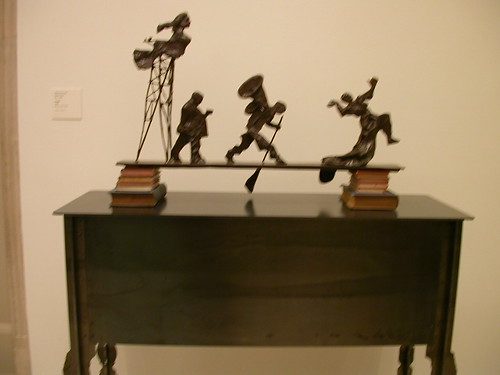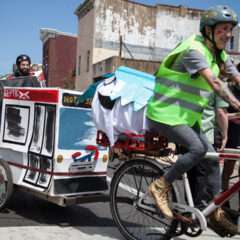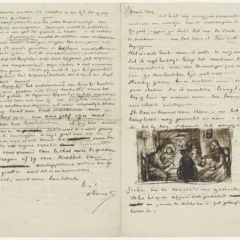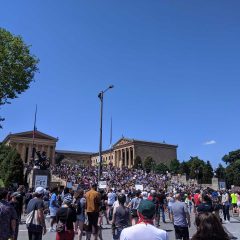This week’s Weekly has my review of the William Kentridge tapestries at the PMA. Below is the copy with some pictures. More photos at flickr and Libby’s post is here.
Rugged Lives
Tapestry nomads weave a spell.

Porter Series: Géographie des Hebreux ou Tableau de la dispersion des Enfants de Noë, 2005, William Kentridge. Tapestry weave with embroidery: mohair, acrylic, and polyester. 100 1/2 x 137 7/8 inches (255.3 x 350.2 cm). Collection of Anne and William Palmer, New York.
The drama of human migration plays out in William Kentridge’s monumental tapestries now on view at the Philadelphia Museum of Art. Eleven large works in all—one of them owned by the PMA (Office Love) and 10 others from the artist’s Porter Series on loan from collections around the world—showcase a march of dark, silhouetted figures carrying bundles and belongings as they move forward. The backgrounds of the beautiful woven and embroidered images are maps from the 1830s, and the juxtaposition of static, elegant maps with dynamic, hulking figures couldn’t be more direct.
The amazingly detailed works, designed by the artist and woven in the Marguerite Stephens’ South Africa workshop, take over PMA’s large contemporary art gallery and read like huge stop-motion animation cels whose imagery provokes a dialog about territory, ownership and the struggle to protect self-interests. The contemporary relevance is clear.

Porter Series: Egypte, 2006, William Kentridge. Tapestry weave with embroidery: mohair, acrylic, and polyester. 99 1/2 x 134 inches (252.7 x 340.4 cm). Courtesy of Lia Rumma Gallery, Milan.
Kentridge, born in 1955, has always made art that, while voicing outrage at the legacy of apartheid in his homeland, transcends any particular time and place. It speaks to the human condition.
He’s known primarily for his labor-intensive animations based on his drawings. He calls the videos “projected drawings.” With the tapestries he’s found another way to project his imagery full-scale.
At the December opening Kentridge spoke with Princeton poet and English professor Susan Stewart in a conversation that was part of the new PMA/Art and Social Transformation lecture series. The artist came to art after studying political science and African studies, and finding his voice through theater, puppetry and drawing. He was asked whether the migratory people were based on the Bantu people. “I wasn’t thinking of specific migrations but of the dispersal of people from tribal to urban and urban to outside-the-urban areas,” he replied.

Porter Series: Norwège, Suède et Danemark (Porter with Chairs), 2005, William Kentridge.
Tapestry weave with embroidery: mohair, acrylic, and polyester. (274.3 x 198.1 cm). Private collection.
He also spoke about people who carried things for a living—porters. “Africa still has people who do labor that’s extraordinarily physical, carrying things [like] scrap metal, recycling, etc.,” Kentridge said. “But it could also be Kosovo or Darfur.”

Office Love, 2001, William Kentridge. Tapestry weave with embroidery: mohair, acrylic, and polyester. 135 7/16 x 179 1/2 inches (344 x 455.9 cm). Philadelphia Museum of Art; Purchased with funds contributed by the members of the Committee on Modern and Contemporary Art.
On display are the artist’s sculptures, drawings and a book on the same theme. PMA’s purchased Kentridge tapestry Office Love is a static image in comparison to the vigorous porters from the Porter Series. It shows a male figure with a typewriter on his head and a high table with a blotter and a scissor. The two figures with their man/machine natures bear a resemblance to Duchamp’s Bride Stripped Bare by her Bachelors, Even (a piece also owned by the PMA), which is perhaps one reason they purchased the work. The office love scene is somewhat ominous with a threat of violence lurking in the large scissors and the typewriter-headed man. But like Duchamp’s love between the bride and the bachelors, the threat or love is never to be consummated.

Kentridge’s tapestries are part of the PMA’s Notations Series, which looks at contemporary art from a non-Western point of view. This is the first Notations to showcase the work of a solo artist. The exhibit is accompanied by a fully illustrated catalog with several fine essays on Kentridge’s art, the art of tapestry through the age and the role of art in South Africa.
PMA continues to prove its commitment to leading the discussion in contemporary art, showcasing art that raises moral and ethical issues at a time when fashion dictates lighter fare.

William Kentridge and Marguerite Stephens annotate a copy of a source drawing. Photo by John Hodgkiss, courtesy of the William Kentridge Studio.
The catalog for this exhibit, funded in part by PEI and in part by the Jerry and Dina Wind, is great — generously illustrated with many color plates and close-up shots of the tapestries, and with shots taken of the weavers making the works. PMA Curator of Contemporary Art Carlos Basualdo situates the works in Kentridge’s oeuvre as coming from the artist’s extensive work with puppets. Labor has always been one of Kentridge’s themes and here, Basualdo says, the Porters provide the most basic form of labor — necessary for people and goods in transit for whatever reason. Gabrielle Guercio places the works in the context of the history of tapestries: They stand apart as works that “do not fulfill the expectations of decor, luxury and status commonly linked with tapestry.” She also credits the works with restoring to tapestry “the dignity it enjoyed before the divide between art and craft…” and doing so without having to espouse religious doctrine or patronly requirements. Ivan Vladislavic’s rumination on the transformation of farmland to cityscape raises issues about ownership, mapping and renaming of land (“Territory is reclaimed through being renamed,” he says.) As the debut volume for the Notations series, this is a classy book.
William Kentridge: “Tapestries”
Through April 6. Philadelphia Museum of Art, 26th St. and the Pkwy. 215.763.8100.








